MICROPILLAR COMPRESSION
Compared with conventional instrumented indentation (e.g., nanoindentation), the microscale compression test of a geometrically defined pillar has the obvious advantage of a relatively uniform stress-strain field. The main issue with instrumented indentation is that the stress-strain field underneath the indenter is highly complex and depends on the specific indenter tip geometry. In addition, the extraction of uniaxial stress-strain constitutive relations from indentation is very difficult and requires complicated iterative methods.
Micropillars can be manufactured by a range of techniques, including Focused Ion Beam (FIB) milling, replication techniques, or LIGA. They provide a small volume of material with a very defined geometry (commonly cylindrical or square). Various experimental variables may affect the stress-strain characteristics of the material being tested, namely the aspect ratio (the ratio of height and diameter of the pillar), the size of the substrate under the pillar, the taper angle (micropillars are often tapered due to the FIB milling process), the stiffness of the substrate and the misalignment between the pillar axis and the compression direction.
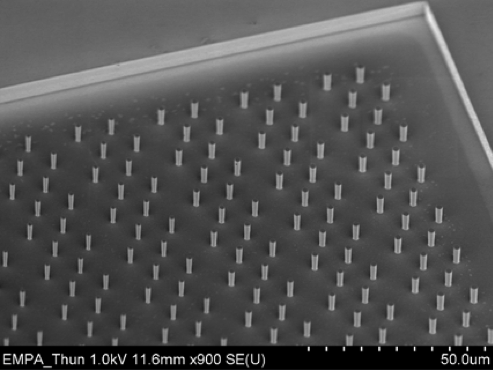
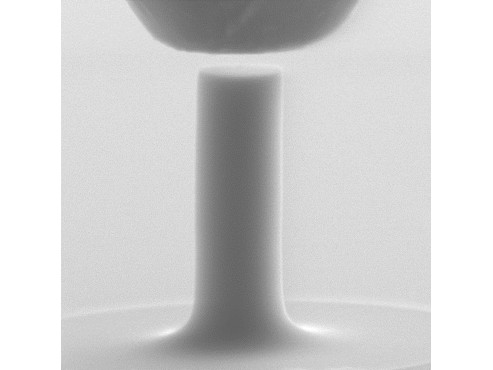
Examples of Si micropillar arrays (left) made by lithography and a single micropillar (right) just before contact with a diamond flat punch indenter
Compression testing is usually performed using a flat punch indenter which has a slightly larger diameter than the micropillar itself. Alemnis can provide flat punch indenters in a wide range of materials (e.g., diamond, tungsten carbide, sapphire, ruby, silicon carbide, boron nitride, stainless steel, etc) and a wide range of diameters, from 2 to 400 µm with a typical cone angle of 60°. Custom indenter geometries (e.g., pyramidal, spherical, knife, wedge, etc.) are also possible, on request. Special geometry indenters may be used for specific applications where simple compression is replaced by cutting or fracture.
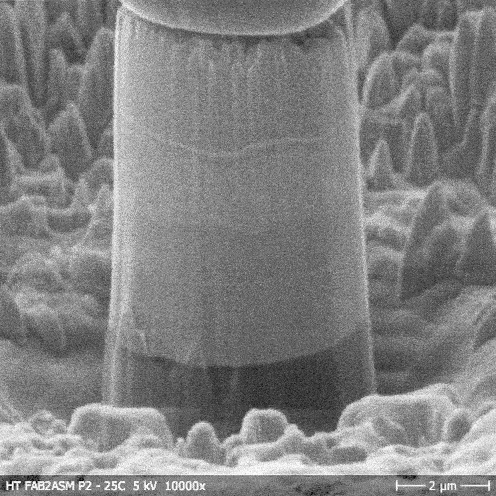
Example of a micropillar compression test on a micropillar built from a multilayer stack of different coatings
There may be various size effect phenomena in pillar compression experiments, one of the most common being that the flow stress of the material increases as the size of the pillar is decreased. This has been documented in a number of cases in single phase materials at small scales. The micropillar compression test can therefore be very useful to study size effects, in terms of deformation behavior, dislocation movement or strengthening mechanisms. In a typical test, the initial compression will cause linear elastic behavior up to the elastic limit (or yield point), after which plastic deformation will become dominant. In the plastic regime, various types of deformation mode may be observed, e.g., serrated plastic flow which is manifested by sudden load drops and reloading periods where dislocation “slip” is occurring.
The ASA can also be used to conduct creep tests on micropillar specimens (by holding the applied load constant and measuring the creep in the displacement signal) or stress relaxation experiments (by holding the micropillar under a fixed deformation and monitoring the variation of applied load). Other variants of the compression test include fracture studies, where the micropillar may be intentionally fractured by indenting with a sharp indenter (e.g., cube corner), or split using a wedge-shaped indenter over a defined area. Micropillars can also be produced with a notch to force the fracture at a specific location. Fatigue tests can be made on micropillars by cycling the load or displacement in a continuous or increasing manner to investigate when a specific volume of material fails by fatigue fracture, e.g., in Micro Electro Mechanical Systems (MEMS).
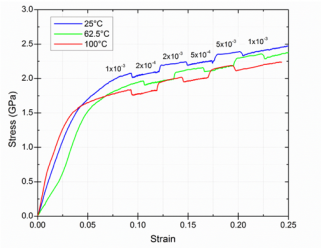

Example of a series of strain rate jump tests performed on nanocrystalline Ni micropillars at various temperatures (from Ref. 3)
Although many micropillar compression tests are performed in-situ inside an SEM, it is also possible to mount the ASA ex-situ and use an optical microscope to align the flat punch indenter on the micropillar. Such an ex-situ approach can also be used to perform unique experiments which could not be performed inside the SEM, e.g., non-conductive or fragile materials, biomaterial micropillars submerged in liquid for simulating true “in-service” conditions, electrical contact resistance experiments, electro-chemical evaluations, etc.
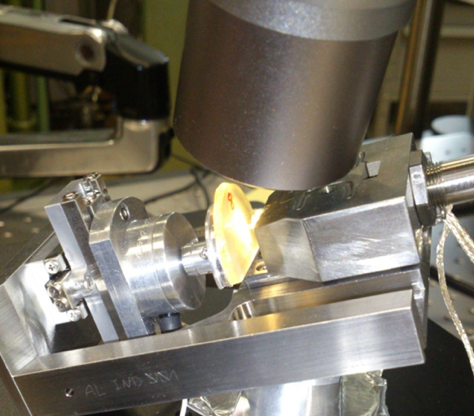

Experimental setup for ex-situ micropillar compression of a polymeric melt-spun fibre (from Ref. 2)

Load-depth plot for a micropillar compression test on a sapphire pillar containing a 20 nm Nb layer (Courtesy of Imperial College, London, UK)
Application notes:
Designing micropillar strain rate jump tests to study time dependent plasticity.
Send download link to:
Micropillar microcompression of fibre samples in air.
Send download link to:
Selected References
- Rabier J, Montagne A, Wheeler J, Demenet J, Michler J, Ghisleni R. Silicon micropillars: high stress plasticity. Phys Status Solidi 10 (2013) 11-5
- Leal, G. Mohanty, F. A. Reifler, J. Michler, R. Hufenus, Mechanical response of melt-spun amorphous filaments, Sci. Technol. Adv. Mater. 15 (3) (2014) DOI: 10.1088/1468-6996/15/3/035016
- G. Mohanty, J. M. Wheeler, R. Raghavan, J. Wehrs, M. Hasegawa, S. Mischler, L. Philippe, J. Michler, Elevated temperature, strain rate jump microcompression of nanocrystalline nickel, Philos. Mag., Vol. 95, 16-18 (2015) 1878-1895
- Schwiedrzik J, Raghavan R, Rüggeberg M, Hansen S, Wehrs J, Adusumalli RB, et al. Identification of polymer matrix yield stress in the wood cell wall based on micropillar compression and micromechanical modelling. Philosophical Magazine 2016;96:3461-78.
- Lunt AJ, Mohanty G, Ying S, Dluhoš J, Sui T, Neo TK, et al. A comparative transmission elec-tron microscopy, energy dispersive x-ray spectroscopy and spatially resolved micropillar compression study of the yttria partially stabilised zirconia-porcelain interface in dental prosthesis. Thin Solid Films 2015;596:222-32.
- Soler R, Wheeler JM, Chang H-J, Segurado J, Michler J, Llorca J, et al. Understanding size effects on the strength of single crystals through high-temperature micropillar compression. Acta Materialia 2014;81:50-7.
- Schwiedrzik J, Raghavan R, Bürki A, LeNader V, Wolfram U, Michler J, et al. In situ micropillar compression reveals superior strength and ductility but an absence of damage in lamellar bone. Nature materials 2014;13:740-7
- H. E. Weekes, V. A. Vorontsov, I. P. Dolbnya, J. D. Plummer, F. Giuliani, T. B. Britton, D. Dye, In situ micropillar deformation of hydrides in Zircaloy-4, Acta Materialia 92 (2015) 81-96
- T-S Jun, Z. Zhang, G. Sernicola, F. P. E. Dunne, T. B. Britton, Local strain rate sensitivity of single α phase within a dual-phase Ti alloy, Acta Materialia 107 (2016) 298-309
- Mohanty G, Wehrs J, Boyce BL, Taylor A, Hasegawa M, Philippe L, et al. Room temperature stress relaxation in nanocrystalline Ni measured by micropillar compression and miniature tension. Journal of Materials Research 2016; 31:1085-95.
- Abad OT, Wheeler JM, Michler J, Schneider AS, Arzt E. Temperature-dependent size effects on the strength of Ta and W micropillars. Acta Materialia 2016;103:483-94.
- Keller, L.M., et al., Understanding anisotropic mechanical properties of shales at different length scales: In situ micropillar compression combined with finite element calculations. Journal of Geophysical Research: Solid Earth, 2017. 122(8): p. 5945-5955.
- Xiao, Y., et al., Investigation of the deformation behavior of aluminum micropillars produced by focused ion beam machining using Ga and Xe ions. Scripta Materialia, 2017. 127: p. 191-194.
- Wehrs J, Deckarm MJ, Wheeler JM, Maeder X, Birringer R, Mischler S, et al. Elevated temperature, micro-compression transient plasticity tests on nanocrystalline Palladium-Gold: Probing activation parameters at the lower limit of crystallinity, Acta Materialia 129 (2017) 124-137
- Best JP, Wehrs J, Maeder X, Zechner J, Wheeler JM, Schär T, et al. Reversible, high temperature softening of plasma-nitrided hot-working steel studied using in situ micro-pillar compression, Materials Science and Engineering: A 680 (2017) 433-436
- L. M. Keller, J. J. Schwiedrzik, P. Gasser, J. Michler, Understanding anisotropic mechanical properties of shales at different length scales: In situ micropillar compression combined with finite element calculations, Journal of Geophysical Research: Solid Earth, 2017. 122(8): p. 5945-5955.
- S. Wang, F. Giuliani, T. B. Britton, Variable temperature micropillar compression to reveal <a> basal slip properties of Zircaloy-4, Scripta Materialia, 162 (2019) 451-455


